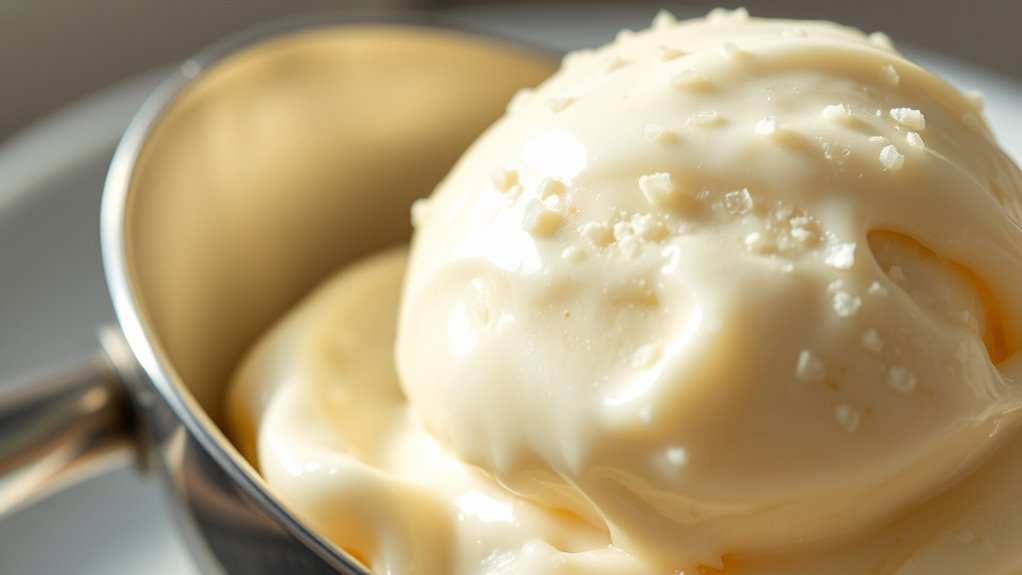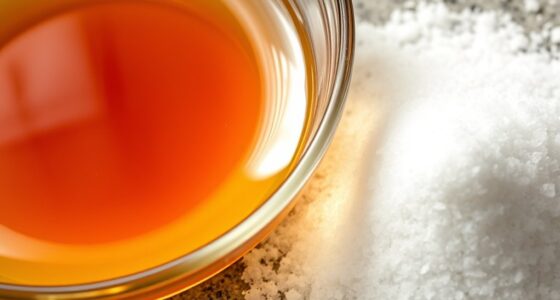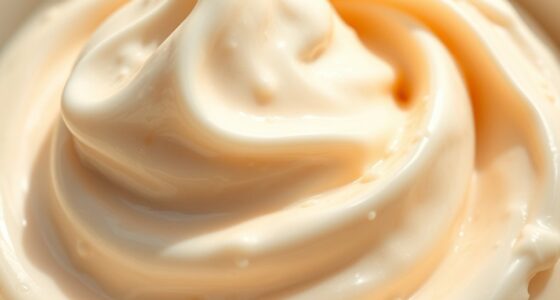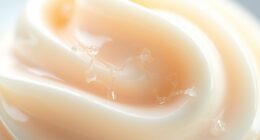Milk solids and non-fat milk are key to building the body and texture of your ice cream. They provide essential proteins and milk fats that create a rich, stable, and creamy structure. By balancing these components, you can improve mouthfeel, prevent crystallization, and achieve the perfect consistency. Understanding how these ingredients work together helps you craft satisfying, high-quality frozen treats. Keep exploring to discover how mastering these elements can elevate your ice cream creations.
Key Takeaways
- Milk solids, including cream and proteins, contribute to the rich texture and body of ice cream.
- Non-fat milk provides milk proteins that form a network to trap air and ice crystals, enhancing structure.
- Increasing cream content boosts fat levels, resulting in a smoother, more luxurious mouthfeel.
- Balancing milk solids prevents ice crystal growth, ensuring stable, creamy consistency.
- Adjusting milk solids and non-fat milk levels allows for fine-tuning ice cream’s richness and stability.
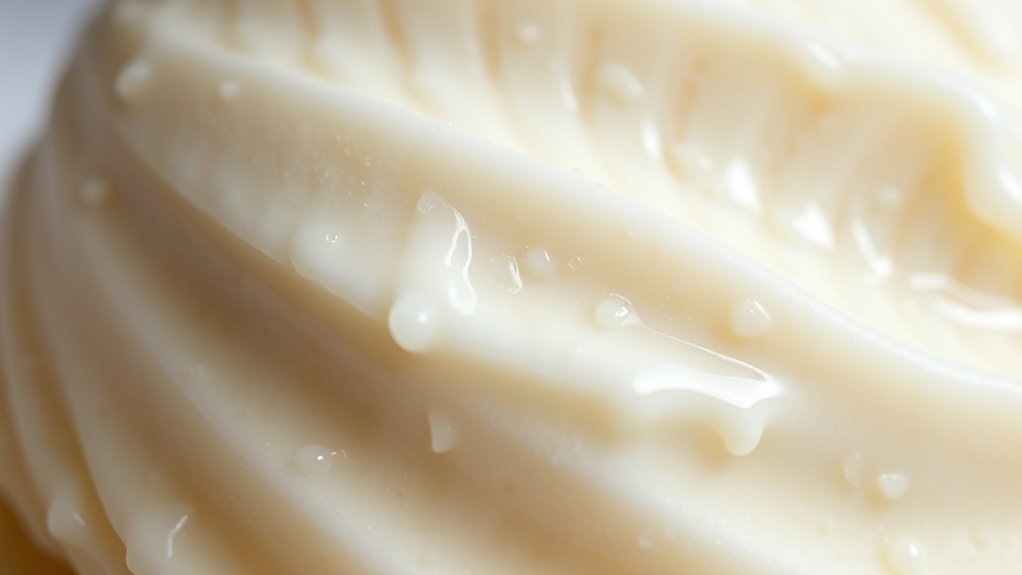
Have you ever wondered what makes up the rich texture and flavor of milk beyond just its liquid? It’s the milk solids that play a essential role in creating that luscious, creamy mouthfeel we associate with dairy and especially in ice cream. Milk solids are composed of both cream content and milk proteins, which contribute notably to the body and stability of frozen desserts. When you’re making ice cream, understanding these components helps you craft a product with the perfect consistency and richness.
Milk solids, including cream and proteins, are key to creating rich, stable, and creamy ice cream textures.
The cream content in milk solids is largely responsible for the smooth, velvety texture you experience. It provides the fat necessary to give ice cream its luxurious mouthfeel and enhances flavor by carrying aromatic compounds. The more cream content you incorporate, the richer and more indulgent your ice cream will feel. But it’s not just about adding fat; balancing the cream content is essential because too much can make the ice cream overly greasy, while too little can result in a product that feels thin or icy. This is where understanding milk solids becomes fundamental. The goal is to achieve a harmonious balance where the cream content elevates the flavor and texture without overpowering other ingredients.
Milk protein is another key component within milk solids that affects the structure and stability of your ice cream. Proteins, such as casein and whey, are responsible for creating a network that traps air and ice crystals, giving your ice cream its structure and preventing it from becoming overly icy or crumbly. Milk proteins also contribute to the overall mouthfeel by providing a slight elasticity and body. When properly incorporated, they help maintain the integrity of the ice cream’s texture as it melts in your mouth, ensuring a smooth, creamy experience from first bite to last.
In essence, both cream content and milk protein are fundamental in building the body of ice cream through milk solids. They work together to create a product that’s not only flavorful but also has the right consistency and stability. As a maker, paying attention to these components allows you to fine-tune your recipe, ensuring your ice cream hits the perfect balance of richness, body, and creaminess. By understanding and controlling the milk solids, you can elevate your frozen creations from basic to extraordinary, offering a satisfying experience that keeps people coming back for more.
Frequently Asked Questions
How Do Milk Solids Affect Ice Cream Flavor?
Milk solids enhance ice cream flavor by adding richness and depth, making each bite more satisfying. They also contribute to flavor enhancement, balancing sweetness and creating a smoother taste. Additionally, milk solids have a nutritional impact, providing essential proteins and sugars that influence overall flavor and texture. By incorporating milk solids, you’ll notice a more robust, creamy flavor and improved mouthfeel, elevating your ice cream experience.
Can Non-Fat Milk Replace Whole Milk in Recipes?
Replacing whole milk with non-fat milk in recipes is possible, but it’s like swapping a full symphony for just the strings—your ice cream might lack richness. Dairy alternatives like non-fat milk can still add flavor enhancement, but you’ll need to compensate with other ingredients for body and creaminess. Keep in mind, the absence of fat affects texture, so adjustments are key to achieving the desired balance.
What Is the Ideal Balance of Milk Solids for Texture?
You should aim for a balance of about 10-12% milk solids, including cream content, to achieve ideal texture. Maintaining the right sugar balance is essential, as it influences creaminess and scoopability. Too little milk solids can make ice cream icy, while too much can cause it to be overly dense or greasy. Adjust these components carefully to create a smooth, creamy consistency that melts perfectly on the tongue.
How Do Milk Solids Influence Melting Properties?
Milk solids act as the backbone of your ice cream, stabilizing its structure like a sturdy frame. They raise the melting point, preventing quick meltaways, and enhance structural integrity, so your ice cream stays firm longer. By balancing milk solids, you control how your ice cream melts, ensuring it remains creamy and enjoyable. Proper use of milk solids keeps your dessert from turning to liquid too quickly, making every scoop perfect.
Are There Health Benefits to Increasing Milk Solids?
Increasing milk solids offers nutritional advantages, providing essential proteins, vitamins, and minerals that support your overall health. However, you should consider dietary considerations, as higher milk solids can also mean more calories and lactose. While they boost flavor and texture, balance your intake to avoid excessive consumption of saturated fats or sugars. Always read labels and consult with a healthcare professional to align with your dietary needs.
Conclusion
Now that you understand how milk solids and non-fat milk build the creamy body of ice cream, you’re ready to craft your own delicious masterpiece. Just like a seasoned alchemist in a Victorian laboratory, you can blend these ingredients to achieve the perfect texture and richness. Remember, the magic lies in balancing these components—so get your hands dirty and create a dessert that’s truly a marvel of modern culinary art.
